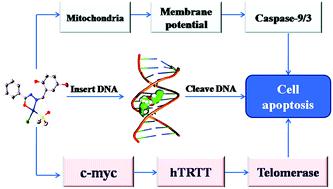当前位置:
X-MOL 学术
›
Metallomics
›
论文详情
Our official English website, www.x-mol.net, welcomes your
feedback! (Note: you will need to create a separate account there.)
Novel Pt(ii) complexes with modified aroyl-hydrazone Schiff-base ligands: synthesis, cytotoxicity and action mechanism.
Metallomics ( IF 2.9 ) Pub Date : 2019-09-12 , DOI: 10.1039/c9mt00193j Jungang Deng 1 , Ping Yu 2 , Zhenlei Zhang 2 , Juzheng Zhang 2 , Sun Zhewen 2 , Meiling Cai 2 , Haoliang Yuan 3 , Hong Liang 2 , Feng Yang 2
Metallomics ( IF 2.9 ) Pub Date : 2019-09-12 , DOI: 10.1039/c9mt00193j Jungang Deng 1 , Ping Yu 2 , Zhenlei Zhang 2 , Juzheng Zhang 2 , Sun Zhewen 2 , Meiling Cai 2 , Haoliang Yuan 3 , Hong Liang 2 , Feng Yang 2
Affiliation

|
To develop new anti-tumour Pt(II) agents, we designed and synthesized five Pt(II) complexes. These Pt(II) complexes were modified benzene rings of 2-hydroxybenzylidene with a hydrocarbyl or halogen group. The five Pt(II) complexes possessed remarkable cytotoxicity against tumour cells in vitro. In particular, we investigated chemotherapeutic mechanisms of the complexes against A549cisR cells. The Pt(II) complexes could bind to and cleave DNA, while also inducing arrest of the cell cycle in S phase, leading to down-regulation of the levels of cyclin-dependent kinases and cyclin and up-regulation of the expression of p21. The selected complex, C3, changed the mitochondrial membrane potential and induced apoptosis. C3 also inhibited the expression of the c-myc gene and downstream proteins, thereby inhibiting telomerase activity.
中文翻译:

具有修饰的芳酰基-席夫碱配体的新型Pt(ii)配合物:合成,细胞毒性和作用机理。
为了开发新的抗肿瘤Pt(II)剂,我们设计并合成了5种Pt(II)配合物。这些Pt(II)配合物是具有烃基或卤素基团的2-羟基亚苄基的改性苯环。这五种Pt(II)配合物在体外对肿瘤细胞具有显着的细胞毒性。特别地,我们研究了针对A549cisR细胞的复合物的化学治疗机制。Pt(II)复合物可以结合并切割DNA,同时还诱导S期细胞周期停滞,从而导致细胞周期蛋白依赖性激酶和细胞周期蛋白水平的下调以及p21表达的上调。选定的复合物,C3,改变了线粒体膜电位并诱导了细胞凋亡。C3还抑制c-myc基因和下游蛋白的表达,从而抑制端粒酶活性。
更新日期:2019-09-12
中文翻译:

具有修饰的芳酰基-席夫碱配体的新型Pt(ii)配合物:合成,细胞毒性和作用机理。
为了开发新的抗肿瘤Pt(II)剂,我们设计并合成了5种Pt(II)配合物。这些Pt(II)配合物是具有烃基或卤素基团的2-羟基亚苄基的改性苯环。这五种Pt(II)配合物在体外对肿瘤细胞具有显着的细胞毒性。特别地,我们研究了针对A549cisR细胞的复合物的化学治疗机制。Pt(II)复合物可以结合并切割DNA,同时还诱导S期细胞周期停滞,从而导致细胞周期蛋白依赖性激酶和细胞周期蛋白水平的下调以及p21表达的上调。选定的复合物,C3,改变了线粒体膜电位并诱导了细胞凋亡。C3还抑制c-myc基因和下游蛋白的表达,从而抑制端粒酶活性。









































 京公网安备 11010802027423号
京公网安备 11010802027423号